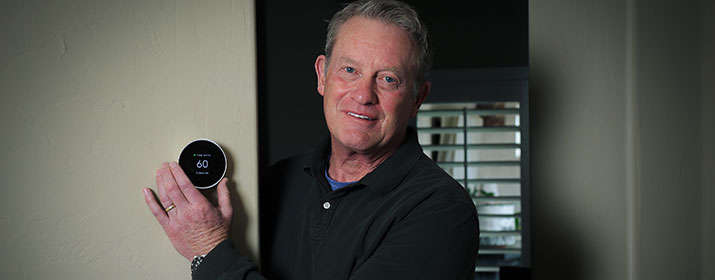
As Pricing Manager for Tucson Electric Power, Rick Bachmeier is very familiar with TEP’s residential pricing plans. In fact, one of his first tasks after joining TEP in late 2014 was to design a new rate structure that included Demand and Time-of-Use (TOU) pricing plans.
Rick knew these plans allow significant savings for customers who shift their usage to off-peak times. Even so, he has been pleasantly surprised by the amount of money he’s saved since switching to the new plans himself: more than $2,000 over five years.
Like most people, Rick and his wife were using TEP’s Basic pricing plan, which charges the same rate per kilowatt hour regardless of when energy is used. They switched to the TOU plan in early 2015 and then, in late 2017, changed to the Demand TOU plan.
Both plans charge more for energy used during peak usage periods but significantly less throughout the rest of the day. That discount offers an opportunity for real savings, and Rick took full advantage of it.
“I’ve been keeping track of my monthly bills to calculate what I would have paid on the Basic plan and what I’ve saved. I also monitor my energy usage online,” he said. “I’ve saved about $2,150 over five years using the Demand TOU rate when compared to the Basic pricing plan, and about $1,600 when compared to TOU.” He’s saved about $28 per month, or about $330 annually, after moving from TOU to Demand TOU.
TEP offers four residential pricing plans: Basic, TOU, Peak Demand and Demand TOU. While the Basic plan is designed to be simple, the other plans more accurately reflect the cost of providing electric service by incorporating two key factors: When energy is used, and how much is used at once.
Timing is Everything
The true cost of service varies significantly throughout the day based on the simple, familiar rule of supply and demand. TEP incurs much higher costs to provide power during the hours when most customers use the most energy. The opposite is also true – energy is much cheaper when there’s less demand for it.
Our Time of Use plans reflect this reality by charging more during peak usage periods and less during the rest of the day. On the TOU and Demand TOU plans, customers who shift their energy usage to off-peak hours can lower their bills by making greater use of discounted energy. Reducing overall usage allows even greater savings.
“If a customer is not ready to try either the Peak Demand or Demand TOU rate plans, they should take a look at our residential TOU rate plan. They may be able to save money on their monthly bills with relatively few behavioral changes and no loss of comfort or convenience.”
Energy on Demand
TEP must build and maintain an energy grid that’s robust enough to satisfy customers’ greatest energy needs – even if those needs don’t last very long. A “demand” charge is designed to recover those costs more accurately by billing customers for their highest hourly energy use during on-peak periods. That, in turn, allows lower rates for energy use.
Our Demand TOU pricing plan offers our lowest rates for off-peak usage but higher rates during on-peak hours. Our Peak Demand plan offers flat usage-based rates that are lower than the Basic rate. Both plans also include a “demand” charge, but that name sounds scarier than it really is, Rick said.
“There is a fear about the higher demand rates charged during on-peak hours that needs to be overcome,” he said. “If you can get over that fear and make a few behavioral adjustments, you will be just fine. You are paying a demand charge, but your energy rate is cut by almost half.”
Because on-peak hours are limited to weekdays, weekends are an ideal time to do chores that use a lot of energy, such as laundry, without concern about driving up your demand charge.
Customers using TOU and demand plans can save the most money by limiting energy use during on-peak hours, which include weekdays between 6-9 a.m. and 6-9 p.m. from October through April and weekdays between 3-7 p.m. from May through September. To explore our pricing plans and find one that’s best for your energy usage, use our pricing planner tool.
Lower Usage, Lower Bills
Besides changing plans, Rick also was mindful about how he used energy and made some adjustments, especially during on-peak hours:
- Replaced all incandescent lights with LED bulbs
- Avoids using larger appliances and smaller electric appliances – such as hair dryers and toaster ovens – during on-peak hours
- Installed a smart thermostat and programmed it to align with TOU hours
- Upgraded his major appliances with ENERGY STAR® certified models
- Pre-cools the home during off-peak hours in hotter months and then raises the thermostat to 80 during on-peak hours
- Uses ceiling fans to make it feel cooler indoors during the summer
- Replaced his single-speed pool pump with a high efficiency variable-speed pool pump, which is programmed to run during off-peak hours
“Our home is about 20 years old, but thankfully it is well insulated,” Rick said. “We’ve been able to make behavioral changes because it’s just my wife and me in the home. It would be more challenging for families on demand pricing plans because everyone in the household would need to be on the same page, but it can be done.”
Customers can log into their TEP account to use online tools, such as My Energy Usage to review their monthly, daily and hourly use, or see which rates might be a good fit for them by checking out the Pricing Planner.
“Customers having more information about their energy usage is a good thing,” Rick said. “Selecting the right pricing plan and keeping track of where you are midway through the month can help you lower your energy costs.”





